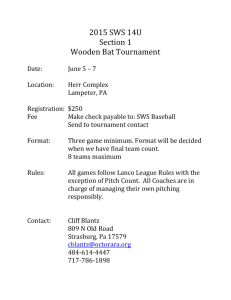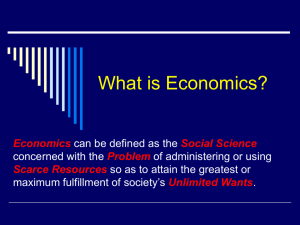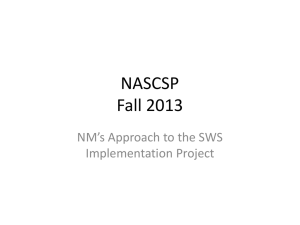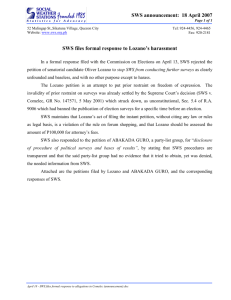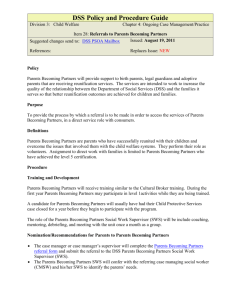Units 1 and 2 Basic Concepts_Brown
advertisement
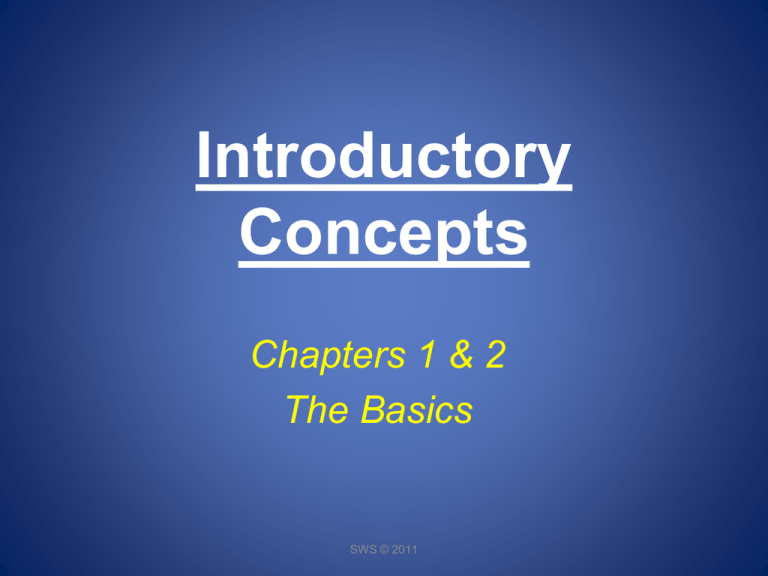
Introductory Concepts Chapters 1 & 2 The Basics SWS © 2011 Economics defined Economics is defined as “the social science concerned with the problems of using scarce (limited) resources to attain maximum fulfillment of society’s unlimited wants.” Without scarcity (limited resources) there would be NO reason to study economics. Can you really have it all? No….not according to economic theory! Please! No more Econ! SWS © 2011 What is Economics About? It is concerned with how society tries meeting people's demands for things they want to consume. It studies production, consumption and sale of goods and services, both at the level of individual products, businesses and consumers and at the level of the total production and consumption by countries. It also compares alternative ways of using the limited resources that countries and individuals possess. SWS © 2011 Macro- vs Micro-Economics Macroeconomics (large scale): the study of national and global economies (highly “aggregated” units) (EXAMPLES: USA, Britain, European Union) “Aggregated” = “total” This study comes later in the semester Microeconomics (small scale): the study of individual decisions and markets (narrowly defined units) EXAMPLES: you buy a movie ticket verses a pizza Basically, we study single product markets, like IPODS, and how prices for those goods are set. SWS © 2011 Wants vs. Needs 1. Society’s material wants, that is, the material wants of its citizens and institutions are virtually unlimited (we will never be satisfied) 2. Economic resources, which are the means of producing goods and services are limited or scarce. 3. Two fundamental facts constitute the “Economizing problem” and provide a foundation for the study of economics. SWS © 2011 What’s causing the Economizing Problem? What is a “material want”? 1. “the desire of consumers to obtain and use various goods and services that provide utility.” Utility is defined as any good or service that gives pleasure or satisfaction “utility = happiness”. Some goods are necessities (needs) others are luxuries (wants). SWS © 2011 Bigger Wants Businesses want factory buildings, machinery, trucks warehouses, communications systems etc. Governments reflecting the collective wants of its citizens or goals of its own, seeks highways, mass transportation systems, schools, and military equipment. However, full utility cannot be achieved. Why? …because of scarcity. So, economists hope to achieve economic equity (equality). So that, at least, everyone is treated fairly, even if NO ONE is fully satisfied. The problem gets bigger! Give me MORE! Material wants have a high reproduction rate in today’s markets: – The rapid introduction of new products wets our appetites – Extensive advertising persuades us that we need items we might not otherwise desire. EXAMPLES: IPODS, XBOX, COMPUTERS, LUXURY CARS, ETC. SWS © 2011 What are Economic Systems? An Economic System is: …an institution that deals with the production, distribution and consumption of goods and services in a society. There are 3 types of economic systems in the world. Market Command Mixed SWS © 2008 Economic Systems GOAL: of all economic study and activity is to satisfy diverse material wants (keeping in mind that resources used to make them are scarce) If this is the GOAL…how do we achieve it? What questions should we ask? SWS © 2011 The Goal of Economic Systems The 3 Fundamental Economic Questions individuals, businesses, and nations must ask in order to start an effective & efficient economic system: 1. For whom will it be produced? 2. What will be produced? 3. How will it be produced? REMEMBER: WHAT, HOW, FOR WHOM SWS © 2011 3 Types of Economies 1. Market economies (also called capitalism) A method or organization that allows unregulated prices and decisions of private property owners to resolve the basic economic problems. (NO GOVERNMENT REGULATION) Examples: New Zealand & Ireland 2. Command economies (also called communism) An economy where the government control all means of production. (TOTAL GOVERNMENT REGULATION) Examples: CUBA & North Korea 3. Mixed economies (also called free enterprise) An economy where the government regulation AND private business control the factors of production. Examples: USA, Europe, most superpowers SWS © 2011 Economic Systems? Economic Systems Chart Command Market Mixed Role of government Decides all economic activity Little or no role of govt. Govt. creates laws and regulates business activities Freedom of choice No Freedom of choice Consumers and producers have freedom of choice Limited freedom of choice given govt. controls Ownership of natural resources Public sector Private sector Both public and private sector Price determination Govt. sets prices Price mechanism system determines price Price mechanism system but regulated by govt. Which sector answers the basic economic questions? Public sector Private sector Both public and private sector Whose ideas are these? 1. Market economies (capitalism) 2. Command economies (communism) 3. Mixed economies (free enterprise) SWS © 2011 Adam Smith (1723 – 1790) The Father of Economics 1776 – Wealth of Nations Free markets and private ownership will provide jobs, profits, and an increasing standard of living. “Pure Capitalism” (Market economy = no government regulation) All economic activity is governed by an “invisible hand” or market competition (greed) – “If you leave a economy alone, people’s need for goods will be enough to keep the economy going” SWS © 2011 Pure Capitalism Private ownership of factors of production. Business choose what to sell, who to sell to, and set prices. Consumers choose what to buy and where to buy it. Economic Freedom!! NO Govt. intervention. PROBLEMS WITH CAPITALISM: Flow of information and goods is not balanced. Unequal distribution of power and wealth. Basically, the poor can be really poor and the rich can be very rich. No Govt. regulation of wages, education or business. (ex. Pollution..) SWS © 2011 Karl Marx (1818 – 1883) 1887 wrote Das Kapital “Communism”: The govt., representing the people, should own all factories and companies. (public goods) All people will have their needs taken care of through the govt. control of resources. Problem? What if Govt. does not do what is in the best interest of the people? Who owns the factors of production in a command economy? ANSWER: THE GOVERNEMNT SWS © 2011 John Maynard Keynes (1883 – 1946) 1936 wrote - The General Theory of Employment, Interest and Money 1930’s The Great Depression hit hard (government needed a new, more regulated, economy) Keynes stated that government should use spending and taxation to stabilize the market. Some believe his theories helped America win WWII Adam Smith would not have agreed. The U.S Economy is governed by his theories.. This system is call a Mixed Economy Somewhat free market for growth and government intervention for stability and full employment. SWS © 2011 Where do they stand? Communism / SOCIALISM Karl Marx Keynesian ECONOMICS John Keynes AUSTRIAN ECONOMICS / Capitalism Free Enterprise Economists Adam Smith The Foundation of Economics What do each of the 3 economic systems (market, command, mixed) have in common? “Economic resources are limited in supply or scarce.” What are economic resources? All natural, human, and manufactured resources which go into the production of goods and services. These are called the… 4 FACTORS OF PRODUCTION. SWS © 2011 The Factors of Production (REMEMBER “CELL”) 1. Capital 2. Entrepreneurship 3. Land 4. Labor The Factors of Production 1. Capital - (two types of capital) Capital Goods (physical capital) – This factor includes all elements (manufactured) that aid production, that is, all man-made tools, machinery, equipment, and factory, storage, transportation, and distribution facilities used in the producing goods and services and getting them to the consumer. Human Capital (mental know-how) – This factor includes people’s ability to learn a new task. – Sometimes referred to as Human Resources, this resource is the most important, especially as the industries of the world use more and more technology. SWS © 2011 The Factors of Production 2. Entrepreneurial Ability – The Entrepreneur (someone who starts a business) performs three related functions: 1. The entrepreneur is the driving force behind production. 2. The Entrepreneur makes basic business policy decisions: decision maker 3. The entrepreneur is a risk taker. 3. Labor – Labor is a broad term for all physical and mental talents. SWS © 2011 The Factors of Production 4. Land (natural resources) To the economist, land is not just real estate! Land is all natural resources usable in the production process. Such resources as land, forests, minerals, oil deposits, air, water and virtual resources come under the classification. Remember the word “C.E.L.L.” SWS © 2011 Review • What are the 3 fundamental economic questions? • Which economic system is Adam Smith associated with? Karl Marx? John Keynes? • What is scarcity? • What are the 3 economic systems? • What are the 4 factors of production? SWS © 2008 How do these Factors of Production flow in any economy? SWS © 2011 The Circular-Flow of Goods Diagram FLOW OF GOODS AND SERVICES Revenue Spending Product Market Goods & Services sold Firms SELL here Households BUY here Goods & Services bought IMPORTANT!! Example of question: What do households and firms do in the factor (resource) market? Firms Inputs for production Factor Market Households Labor, land, and capital (Resource Market) Costs Firms BUY here Households SELL here SWS © 2011 Income BillyBob works for a lumber company and makes $20/hr. The lumber company sells wood for $1,000 per crate to a company that makes cribs. The crib company sells cribs to Walmart for $100/crib. BillyBob just had a baby and has to buy a crib that Walmart is selling for $150. Using the model below, construct a circular-flow diagram. What do the 3 economists have in common? (Smith, Keynes, Marx) They all had a similar definition of how to promote economic stability. SWS © 2008 Economic Stability has 2 Concerns: Full employment and stable prices. Full employment: Full employment means the use of all available resources. Stable Prices: 1.Keeping prices stable helps an economy maintain a balance between consumers’ income and suppliers’ prices. 2.Stable prices help consumers, suppliers, and governments predict the future more accurately. The best way to achieve full employment and stable prices to use resources efficiently. Efficiency (Best use of the resources available) Simply meaning to allocate (divide) wisely and minimize costs SWS © 2011 What helps promote efficiency? 1. Division of labor: -- breaks down the production process into a series of specific tasks performed by different workers. Division of labor allows for the adoption of massproduction technology. Ex- car wash/lawnmowing 2. Specialization: individualized focus on one task. Specialized workers become more skilled over a shorter period of time. Dividing labor among various specialized tasks will allow a company (or nation) to produce items with less cost. SWS © 2008 Which Costs are Important? All economic/business reasoning focuses on the impact of marginal (small) changes between decisions. Economic decisions will be based on marginal (small / individual) costs and marginal (small / individual) benefits. Since goods are scarce, uncertainty is a fact or life, but we can use OPPORTUNITY COST to help us make economic/business decisions. “The marginal value of the best possible alternative that is given up in the decision to use a resource.” OPPORTUNITY COST OPPORTUNITY COST helps us make economic (monetary) decisions, business & personal. “The marginal value of the best possible alternative that is given up in the decision to use a resource.” It is all about choices: Friday Night Choice A: Football Game (ticket & dinner at concession) Friday Night Choice B: Movie with friends (Chick-fil-A & popcorn) If you choose the football game, A, the COST of that OPPORTUNITY is choice B, the movie. You are giving up the movie, so that is your Opportunity Cost. Let’s pull it all together: Scarcity, Allocation, Opportunity Costs & and this thing we call the Production Possibility Frontier (PPF) (A simple means of measuring lost opportunities) SWS © 2011 Production Possibilities Frontier Model (PPF) Shows possible combos of two types of goods that can be made when available resources used efficiently Assumptions for PPF Only 2 products Focus on one period of time (year, month, etc) During that time, resources are fixed in quantity/ quality. Technology does not change during the time the model indicates. SWS © 2008 Production Possibilities Curve for Susan’s Grades in English and Economics (10 Hrs of Study) • Consider Susan, a student who only has 10 hours of study to divide between her economics and English classes. • If Susan spends most of her time studying economics, she can earn an A in economics . . . and a D in her English class. • If Susan splits her time between the two, she can earn a B in economics . . . and a B in her English class. • If Susan spends most of her time studying English, she can earn an D in economics . . . and an A in her English class. • Mapping out all the possibilities of how Susan can divide her time (resources) between these activities shows us her Production Possibilities Curve (PPC). Expected Grade in Economics (y) Production Possibilities Curve A B C D F SWS © 2011 D C B A Expected Grade in English (x) Production Possibilities Curve for a Nation’s Economy (Given Limited Resources) • Consider the economy of a nation which has limited resources to divide between Production Possibilities Output the production of clothing and food. Only clothing Curve of • If the nation allocates all of its resources is produced toward the production of clothing, then Clothing it can produce at point S. S All output • If the nation allocates all of its resources possibilities A on the toward the production of food, then it frontier can produce at point T. curve are • Mapping out all the possibilities of how efficient B D the nation can divide its resources between these activities shows us the nation’s Production Possibilities Curve. • Output combinations A, B, and C are - Inefficiency all on the PPC are therefore C Only food is produced efficient allocations of resources. • Output combination D is within the PPC and therefore represents an inefficient allocation of resources. T Output Note that the nation could produce the of same level of clothing while producing Food a greater quantity of food at point B. SWS © 2011 Shifts in the PPF Increase in available resources CONTEMPORARY ECONOMICS: LESSON 2.1 Decrease in available resources 40 Production Possibilities Curve for a Nation’s Economy (Given Limited Resources) • Consider the following PPFs. • What can we deduct from them? PRODUCTION POSSIBILITIES The PPF illustrates three possibilities of production: 1. All attainable and unattainable combinations of production (what can and cannot be achieved) 2. Full employment and unemployment of resources 3. Tradeoffs What we have to give up to produce more units of a product. SWS © 2011 ATTAINABLE AND UNATTAINABLE COMBINATIONS What does the PPF show? 1. We can produce at any point inside the PPF or on the frontier. 2. Points outside the PPF are unattainable. WHY? 3. Points inside the PPF are attainable. 4. The PPF also displays full employment of resources if one is ON the curve. SWS © 2011 TRADEOFFS AND FREE LUNCH 1. When production is on the PPF, we face a tradeoff. To get more of one good we must give up some of the other good. (same as opportunity cost) 2. When production is inside the PPF, there is not full utilization of resources. We can move to the PPF and get more goods without giving up either good. SWS © 2011 REVIEW OF P.P.F. 1.) What is the opportunity cost of moving from Point C to Point D? 2.) Point G is what? 3.) Anything inside the curve is what? Shifting the Production Possibilities Curve Outward/Inward 1. An increase in the economy’s resources would expand our ability to produce goods and services. 2. Advancements in technology can expand the economy’s production possibilities. SWS © 2011 Shifting the Production Possibilities Curve Outward/Inward 3. An improvement in the rules (laws, institutions, and policies) in the economy can increase output. 4. By working harder and giving up current leisure time, we could increase our production of goods and services. 5. Investment in the future. SWS © 2011 REVIEW OF P.P.F. 1.) What is the opportunity cost of moving from Point C to Point D? Loss of 3 million CDs 2.) Point G is what? Impossible given current resources 3.)Profit for CDs = $5.00 Profit for water = $2.00 What is your total profit of Point B: 14 m x $5.00 = $70 m 1 m x $2.00 = $2 m $72 million (total profit) SWS © 2011 $51 million (total profit) Questions for Thought: 1. What does a production possibilities curve demonstrate? All the possible combinations of two goods that can be produced with current resources. 2. What are the three major types of economies? – – – Mixed = blend of Command and Pure Capitalism Command = government owns all the factors of production Market = private ownership of the factors and NO government regulation 3. Who developed the idea of the “invisible hand” and what does it mean? – Adam Smith: simply, an economy will maintain itself without the need for government regulation (our greed for things will hold the markets together) SWS © 2011 Questions for Thought: 4. What are the factors of production? – C.E.L.L. (capital, entrepreneurship, land, and labor) 5. What is capital? – the MAN-MADE goods used to produced a consumer good 6. What is labor? – all the physical AND human resources (skill level and education) 7. What are the reasons that will cause the PPF to shift outward or inward? – – – – lack of or development of technology Increase or decrease leisure time More resources or less resources (i.e. land, minerals, and labor) Improvement or impairment due to government regulations. SWS © 2011 THE END STUDY VOCABULARY DAILY & COMPLETE YOUR STUDY GUIDE! SWS © 2011
